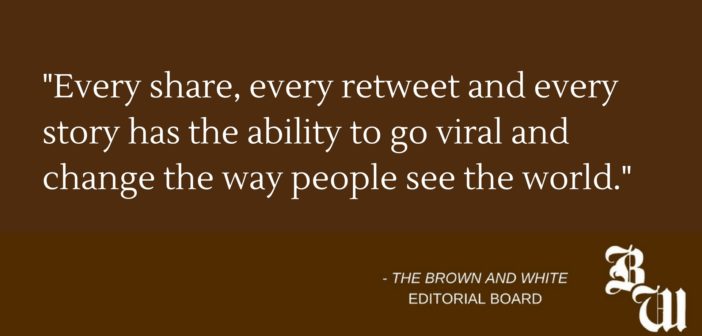Who do you think of when you think of the media?
Maybe you picture images of familiar pundits on TV. Maybe you think of reporters frantically writing articles ahead of deadlines. Maybe you think of paparazzi.
Or maybe you think of “the good guys” and “the bad guys,” a symptom of the so-called “fake news” epidemic. Maybe you feel exhausted, ready to shut out an endless storm of facts and opinions from your life entirely.
That exhaustion isn’t without reason. In a world of increasingly polarized opinions, it’s easy to gravitate toward news sources you trust and dismiss the rest of “the media” as unnecessary.
Confirmation bias is a very real, very comfortable trap that we’re all guilty of falling into at one point or another. There’s just one catch.
No matter what came to mind when you read those words, there’s an uncomfortable truth we need to accept — we are all “the media.”
The power to influence mass opinion, once held solely by major news organizations and public officials, has exploded across the realm of social media. Every share, every retweet and every story has the ability to go viral and change the way people see the world.
The shooting of Philando Castille, streamed through Facebook Live. The inhumane treatment of protesters in Standing Rock, promoted through an influx of videos and pictures. The Arab Spring, organized and enacted through a vast social network.
We have an incredible ability to share information faster than ever before. Impactful events ripple across the country, and occasionally the world, in an instant.
These events in recent history, and countless others, were pushed to the forefront of mainstream news because of people just like you — people sharing things that matter.
With great power comes even greater responsibility.
We’re responsible for fighting for justice and righting wrongs, but we’re equally accountable for the consequences of disseminating false information.
Kyle Quinn, mistakenly identified as a Charlottesville protester, received death threats mailed to his widely distributed home address. Sunil Tripathi, mistakenly identified as the Boston Bomber, was found dead in the Providence River by cause of suicide. Ryan Lanza, mistakenly identified as the Sandy Hook shooter, was taken into custody unaware that his mother and 26 others lay dead at the hands of his brother, Adam.
Spreading information has just as much power to change someone’s worldview as it does to ruin someone else’s life. Whether or not we are conscious of it, everyone makes an impact on their local community through the information they share.
Now more than ever, we need to be aware of how information spreads and affects those around us.
Anyone can reach the conclusion that their opinion is objective truth while everyone else is incorrect or ill-informed.
Anyone can choose to receive information from their favorite news source and denounce others as propaganda. Reports viewed as lies to some might appear as undeniable facts to others.
It takes commitment to put your personal opinions on the back burner in pursuit of the truth. It takes a special kind of individual to sift through the noise to spread facts in careful, deliberate ways.
Like it or not, you are now one of those special individuals. You are the media.
Facts. Opinions. Accountability. Truth.
Who did you think of?






Comment policy
Comments posted to The Brown and White website are reviewed by a moderator before being approved. Incendiary speech or harassing language, including comments targeted at individuals, may be deemed unacceptable and not published. Spam and other soliciting will also be declined.
The Brown and White also reserves the right to not publish entirely anonymous comments.
1 Comment
After leaving The Washington Post in 1977, Carl Bernstein spent six months looking at the relationship of the CIA and the press during the Cold War years. His 25,000-word cover story, published in Rolling Stone on October 20, 1977, is reprinted below.
THE CIA AND THE MEDIA
How Americas Most Powerful News Media Worked Hand in Glove with the Central Intelligence Agency and Why the Church Committee Covered It Up
BY CARL BERNSTEIN
In 1953, Joseph Alsop, then one of America’s leading syndicated columnists, went to the Philippines to cover an election. He did not go because he was asked to do so by his syndicate. He did not go because he was asked to do so by the newspapers that printed his column. He went at the request of the CIA.
Alsop is one of more than 400 American journalists who in the past twenty‑five years have secretly carried out assignments for the Central Intelligence Agency, according to documents on file at CIA headquarters. Some of these journalists’ relationships with the Agency were tacit; some were explicit. There was cooperation, accommodation and overlap. Journalists provided a full range of clandestine services—from simple intelligence gathering to serving as go‑betweens with spies in Communist countries. Reporters shared their notebooks with the CIA. Editors shared their staffs. Some of the journalists were Pulitzer Prize winners, distinguished reporters who considered themselves ambassadors without‑portfolio for their country. Most were less exalted: foreign correspondents who found that their association with the Agency helped their work; stringers and freelancers who were as interested in the derring‑do of the spy business as in filing articles; and, the smallest category, full‑time CIA employees masquerading as journalists abroad. In many instances, CIA documents show, journalists were engaged to perform tasks for the CIA with the consent of the managements of America’s leading news organizations.
http://www.carlbernstein.com/magazine_cia_and_media.php